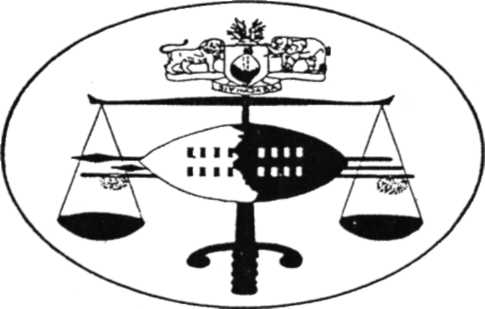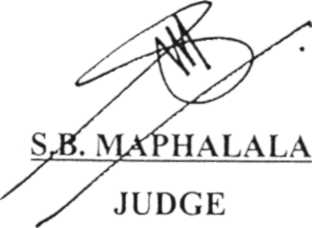

1
THE HIGH COURT OF SWAZILAND CITY COUNCIL OF MANZINI Applicant
And CAMBRIDGE HIGH SCHOOL 1st Respondent J. KWARTENG 2nd Respondent THE LUTHERAN CHURCH 3 rd Respondent Civil Case No. 1293/2003 S.B. MAPHALALA-J MR. B. MAGAGULA MR. E.M. SIMELANE Coram For the Applicant For the Respondents
JUDGMENT (09/07/2004) Before court is an application on motion by a local Municipality interdicting and restraining the Respondents from using Lot 29/125, in the Municipality and division of Manzini, for any purpose other than residential accommodation, as envisaged by the provisions of the zoning described as "general commercial district use" Regulation (C - 2) referred to in the Manzini Development Code, established in terms of the Town Planning Act 45 of 1961.
The founding affidavit of the City Engineer Madoda D. Dlamini is filed in support thereto. Various annexures pertinent to the Applicant's case are also filed of record. The 1st and 2nd Respondents oppose the granting of the order and have filed the answering affidavit of the 2nd Respondent. In turn the Applicant filed a replying affidavit in answer to the Respondents' affidavit. The Respondents had raised preliminary objections in their answering affidavit which were heard by Masuku J who dismissed them in his judgement dated the 7th April 2004. The matter then appeared before me on the merits in the contested motion of the 28th May 2004 where I heard submissions on the law and further directed that viva voce evidence be led. It became evident when the matter was argued that there was a dispute between the parties as to the exact location of the school in relation to the Development Code. The facts of the matter were crispy summarised by Masuku J as follows: "In the year 2003, the Applicant, a local Municipality, duly established in terms of the provisions of the Urban Government Act 8/1969 set out on a crusade to stop the seeming mushrooming of schools in its jurisdictional area, which in its view were operating illegally and in contravention of its development code. As a result of this crusade, the Applicant moved a number of applications before this court interdicting the use of various properties other than for residential purposes. The lsl Respondent is one of such school". The defence advanced by the Respondents is found in paragraph 26 of the answering affidavit of the 2nd Respondent. He avers as follows: "AD Paragraph 31 The contents herein are denied and Applicant is put to strict proof. In particular I deny that the school is located in a residential area which is peaceful. The general area where the school is located is noisy. To put the court on (sic) the picture, this
place is next to the bus rank and near the Trade Fair. Usually you find make shifts garages 26.1 I would also highlight to court that the Applicant seems to be confused about the premises that we are speaking about as it seems not to be the one that it described in paragraph 15, 16, 18 and 19 of the deponents founding affidavit". It is on the basis of the above "confusion" that I directed that viva voce evidence be led to clarify the matter. On the return date the Applicant led the evidence of its City Planner one Elinah Ntombi Wamuweya to clarify the position. She is highly qualified in her field with a B.A. degree and a Post -Graduate Diploma in Urban Service. She testified that the stand from which the 1st Respondent operates is clearly marked on the zoning map as falling within the area demarcated as "C - 2" and not zone "P". The zone "C - 2" is "general commercial district" the uses permitted by right, shall include business premises, offices, flats as an accessory use to the principal use on the plot, places of refreshment, shops, bottle stores and motor vehicle sale yards. She further testified that according to the Manzini Development Code (1991) at 8 - 1 conditional uses permitted by special consent shall include petrol filing stations, bars, places of worship, lodging house and parking lots or garages. Further that uses prohibited shall include all other uses. She testified furthermore that under zone "P" being public facilities district the uses permitted under 12.2 of the Code does not include schools. That in the present case the 1st Respondent has not shown that it obtained permission to run a school within that zone as of right, by special consent or thirdly by re-zoning of the area. The evidence of the City Planner proved clearly that the lsl Respondent was operating a school in an area not permitted by the Code and thus in contravention thereof. The cross-examination by Mr. Simelane did not dislodge her evidence. Therefore it behoves me at this stage to examine the matter on the merits whether the Applicant has met all the requirements for a final interdict, which are trite in law, i.e.
* that are scattered around. *"
a clear right, injury committed or reasonably apprehended, and the absence of similar protection by way of any other remedy. I shall proceed to determine the requirements of the law in seriatum thus: i) A clear right. The submission advanced on behalf of the Applicant in this regard is that it has established a clear right. The Respondents on the other side take the view that it does not constitute a clear right for Applicant to claim that the schools are not registered with the Ministry of Education when there is no positive evidence from the Ministry of Education. The Applicant has become a busy body in matters that do not concern them, alternatively not provided by the Town Planning Act of 1961. It would appear to me that the Applicant has proved a clear right in this matter. Paragraph 1.1 (a) of the Code reads that the Applicant "shall be the local and responsible authority for enforcing and carrying into effect the provisions of this code". In terms of Chapter 21 of the Code, the Town Engineer is seized with the responsibility to administer and enforce the Code. The Respondents' act is in contravention of the Code, which entitles the Applicant to take action in order to enforce the provisions of the Code. According to the decided cases of C/Tzaneen Local Transitional Council vs Louw 1996 (2) S.A. 860 at 863 - 864 and that of Huisamen & others vs Port Elizabeth Municipality 1998 (1) S.A. 477 (E) an Applicant is entitled to apply to court to compel a Respondent to comply with a Code as the instant Code, also by virtue of the common law. As regards the Education Act, I agree with the submission made on behalf of the Applicant that it has a vested right in terms of Section 14 thereof, to nominate a compulsory member of the school committee. As such the Applicant is entitled to protect and enforce its right to be so represented. In the premises, the Applicant has established a clear and definite right to the relief sought.
ii) Injury committed or reasonably apprehended. In this regard I agree in toto with the submissions advanced on behalf of the Applicant that injury is reasonably apprehended, i.e. the Respondents operate the school in contravention of the provisions of the Code and the Education Act. The area is designated for light industrial use, and other residents will be prejudiced in that, inter alia, there would be unnecessary disturbance and intrusion due to the noise and congestion occasioned by the operation of a school or other educational facility. iii) The absence of similar protection by way of any other remedy. The third requisite for the grant of a final interdict is proof that there is no other satisfactory remedy available to the Applicant. A final interdict is a drastic remedy and (probably for that reason) in the court's discretion. The court will not, in general, grant an interdict when the Applicant can obtain adequate redress in some other form of relief (see C.B. Prest, The Law and Practice cf Interdicts (1993) Juta at page 45 and the cases cited thereat). In my mind, on the facts of this matter the Applicant clearly has no alternative remedy, and the Respondent does not suggest anything to the contrary. According to paragraph 26.3 of the Applicant's replying affidavit the 1st Respondent has been given an opportunity since 1999, nearly 4 years to either apply for rezoning or find suitable alternative accommodation. It has not done so. In the result I have come to the conclusion that the Applicant has proved its case for the relief sought. Therefore an order is granted in terms of prayers 1 and 2 of the notice of motion. The effect of this order is suspended for a period of 14 days from the date of this judgement.